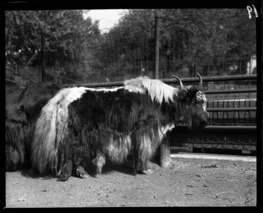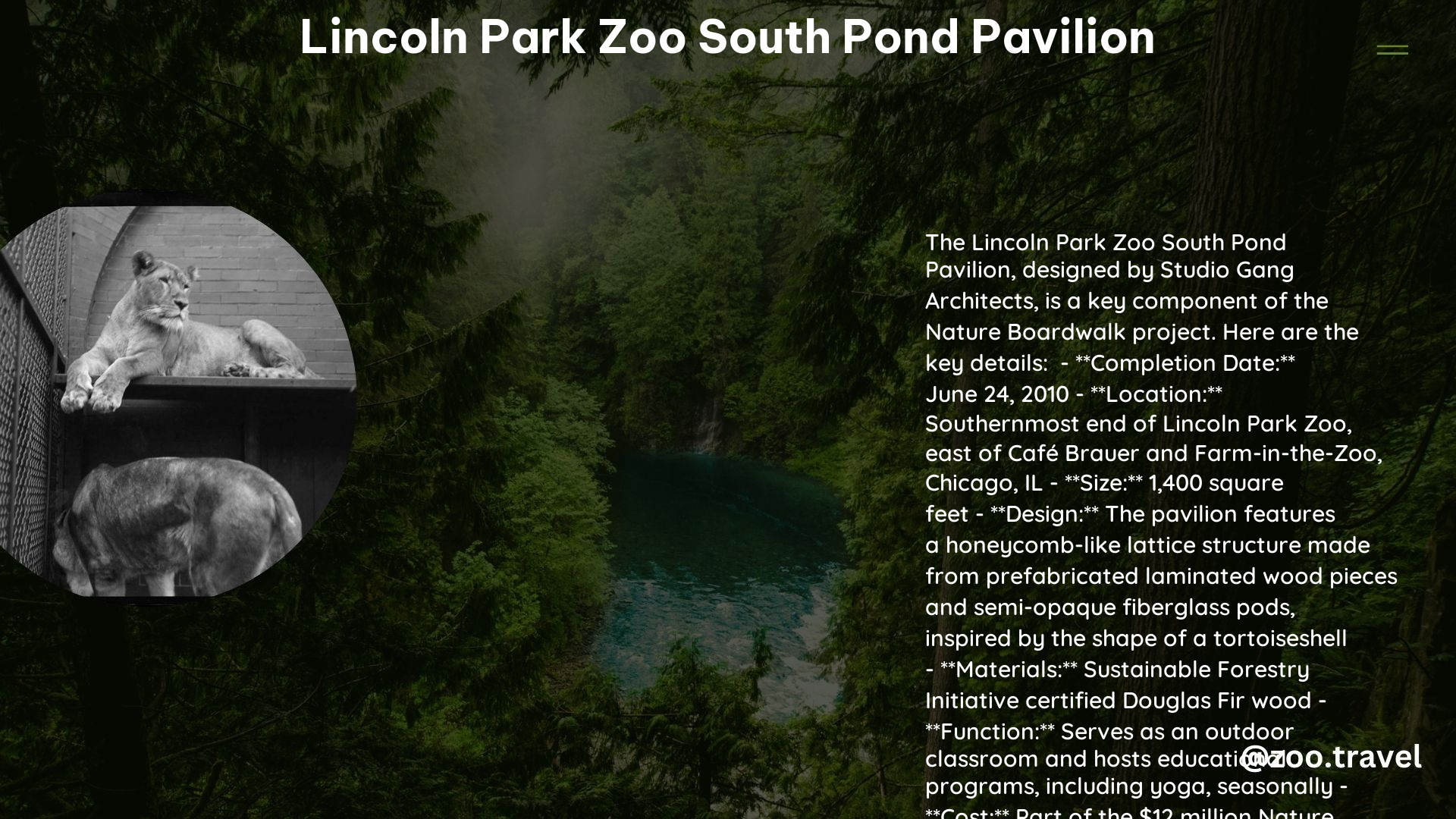The Lincoln Park Zoo South Pond Pavilion, designed by Studio Gang Architects, is a remarkable transformation of a 19th-century urban pond into a thriving ecological habitat. This 14-acre project features a unique tortoise shell-inspired pavilion integrated into a boardwalk that encircles the South Pond. The redesign has significantly improved water quality, hydrology, and landscape, creating a diverse ecosystem that supports both resident and migratory animal populations while serving as an educational hub for visitors.
What Makes the Lincoln Park Zoo South Pond Pavilion Unique?

The Lincoln Park Zoo South Pond Pavilion stands out for its innovative design and ecological focus. Here are some key features that make it unique:
- Tortoise shell-inspired architecture
- Integration with a recycled plastic boardwalk
- Improved water quality and habitat zones
- Educational zones along the boardwalk
- Open-air classroom and event space
The pavilion’s design seamlessly blends form and function, creating a structure that is both visually striking and environmentally beneficial.
How Does the Pavilion’s Design Enhance the Visitor Experience?

The pavilion’s design enhances the visitor experience in several ways:
- Shelter and Comfort: The pavilion provides shelter for open-air classrooms, programs, and events, allowing visitors to enjoy the space in various weather conditions.
- Educational Opportunities: The boardwalk passes through different educational zones, offering insights into the local flora and fauna.
- Immersive Nature Experience: The design allows visitors to feel immersed in nature while still being in an urban setting.
- Sustainable Features: The use of recycled materials and eco-friendly design elements educates visitors about sustainability.
What Ecological Improvements Were Made to the South Pond?
The South Pond underwent significant ecological improvements as part of this project:
| Improvement | Description | Benefit |
|---|---|---|
| Deepening the pond | Increased water depth | Better oxygenation for aquatic life |
| Adding plant shelves | Created new planting areas | Filters runoff water and creates habitat zones |
| Reestablishing watershed | Improved water flow and quality | Supports a more diverse ecosystem |
| Enhancing plant variety | Introduced new plant species | Supports a wider range of animal habitats |
These improvements have transformed the pond from a simple urban water feature into a thriving ecosystem.
What Types of Flora and Fauna Can Be Found at the Lincoln Park Zoo South Pond Pavilion?
While specific species counts are not provided, the improved ecosystem supports a diverse range of flora and fauna:
Flora:
- Aquatic plants on the newly created plant shelves
- Terrestrial plants in the surrounding landscape
- Native species that support local wildlife
Fauna:
- Resident animal populations
- Migratory bird species
- Aquatic life in the improved pond ecosystem
The variety of habitats created by the redesign allows for a rich biodiversity within an urban setting.
How Does the Pavilion Serve as an Educational Resource?
The Lincoln Park Zoo South Pond Pavilion serves as a valuable educational resource in several ways:
- Outdoor Classroom: The pavilion is used for open-air classes and educational programs.
- Interactive Learning: Educational zones along the boardwalk provide information about local ecosystems.
- Demonstration of Urban Ecology: The project showcases how natural habitats can thrive in urban environments.
- Sustainability Education: The use of recycled materials and eco-friendly design elements teaches visitors about sustainable practices.
What Amenities and Activities Are Available at the Lincoln Park Zoo South Pond Pavilion?
The pavilion offers various amenities and activities for visitors:
- Open-air classroom space
- Event venue for programs and gatherings
- Yoga sessions (schedules not specified)
- Boardwalk for leisurely walks and nature observation
- Educational zones for self-guided learning
While specific schedules for activities are not provided, the space is designed to be versatile and accommodate a range of events and programs.
How Does the Pavilion’s Design Contribute to Biodiversity?
The pavilion’s design contributes to biodiversity in several key ways:
- Improved Water Quality: The deepened pond and enhanced water circulation support a wider range of aquatic life.
- Diverse Habitats: The creation of plant shelves and varied landscape features provides habitats for different species.
- Native Plant Species: The introduction of native plants attracts and supports local wildlife.
- Migratory Bird Support: The improved ecosystem serves as a stopover for migratory birds.
- Urban Wildlife Corridor: The project helps connect fragmented urban habitats, allowing for greater biodiversity.
What Sustainable Features Are Incorporated into the Lincoln Park Zoo South Pond Pavilion?
Sustainability is a core aspect of the Lincoln Park Zoo South Pond Pavilion design:
- Recycled Materials: The boardwalk is made from recycled plastic milk bottles.
- Water Conservation: Improved hydrology and filtration reduce water waste and improve quality.
- Energy Efficiency: The open-air design of the pavilion minimizes energy use.
- Habitat Restoration: The project restores and enhances natural habitats within an urban setting.
- Educational Component: The design itself serves as a tool for teaching about sustainable practices and ecosystem management.
How Does the Lincoln Park Zoo South Pond Pavilion Demonstrate the Coexistence of Urban and Natural Environments?
The Lincoln Park Zoo South Pond Pavilion is a prime example of how urban and natural environments can coexist:
- It transforms a 19th-century urban pond into a vibrant ecological habitat.
- The pavilion’s architecture blends seamlessly with the natural surroundings.
- The project improves biodiversity within a densely populated urban area.
- It provides urban residents with access to nature and wildlife education.
- The design showcases how sustainable practices can be integrated into urban development.
By creating this natural oasis in the heart of Chicago, the project demonstrates that cities can be both centers of human activity and havens for diverse ecosystems.
References:
1. South Pond Pavilion, Nature Boardwalk at the Lincoln Park Zoo
2. Nature Boardwalk at Lincoln Park Zoo
3. Movie by Spirit of Space: South Pond by Studio Gang
